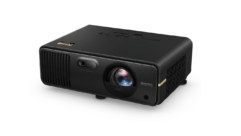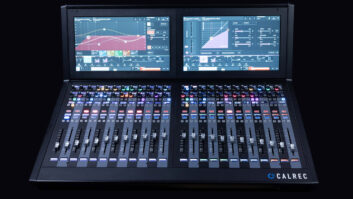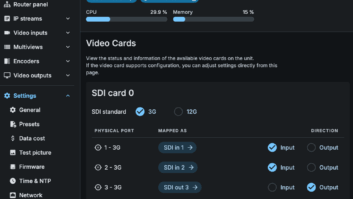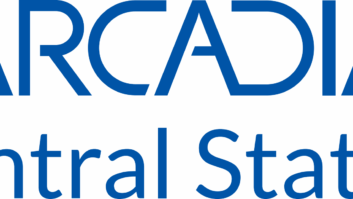Every now and again, I have to take a step back and marvel at the technology we have available to us today. As I began to look at the Digital Projection (DPI) M-Vision Laser 18K projector, it struck me as to how far we have come in a few short years. DPI has created a single-chip, DLP projector with a laser engine that can deliver up to 18,000 ISO (16,000 ANSI) Lumen images. While this is not a small projector, it is not the size of a refrigerator, and it weighs in at a reasonable 108lbs (49kg). The folks at DPI gave me the opportunity to get my hands on the M-Vision Laser 18K, and I will say that it is impressive. The first thing that got my attention was that while it is designed to deliver 18,000 Lumens, it will still operate on a single 120VAC circuit.

With the advent of brighter projectors, we have the advantage of simple and cost-effective solutions for larger venue displays. If you have a screen that is 10’ (3.05m) tall and 16’ wide (4.88m) wide, you can generate a 112 ft-L image on a screen with a gain of 1.0. For those who never did like word problems in school, it means that you have enough light from the projector to successfully create a bright image on a very large screen. Now there is much more to the application of a screen into an environment, but if you have enough image brightness, everything else gets easier.
This M-Vision Laser 18K is a projector well suited into at least two main applications. The first one is permanent installations, and the second is live events. Here are the particulars: To accommodate the capability of an 18,000 Lumen engine, it is a fairly large and heavy projector. It has a 0.96” DMD chip that has a native resolution of 1920×1200 (WUXGA) and a 16:10 aspect ratio. When operating at full light output, it produces a respectable 45dB of noise.
The M-Vision Series of projectors accommodate interchangeable lenses, and DPI has five different lenses options. As with most of the projectors in this class, the M-Vision Laser 18K does not include a lens. All of the lenses are electrically operable, including zoom, focus and shift. DPI has provided 10 user-definable lens presets. The available lenses range from a short 0.84:1-1.03:1 to a very long-throw lens with a ratio of 4.00:1-7.00:1. While each provides a typical range of vertical and horizontal shift, the amount of shift varies. Here are the lens-shift numbers:

I had the 1.20 – 1.56 lens to use for my evaluation. While it performs very well in a large venue, I will admit that I did some testing on my smaller, Da-lite fixed frame screen. I can say that a 12,000 Lumen image on a 113” diagonal (16:10 aspect ratio) screen is an amazing 400 Lumens. This is not a really practical test, but it gave me the opportunity to look very closely at the performance of the projector.
As you can appreciate, this projector has a powerful laser engine that provides the very bright light. The light output is strong enough to produce a serious hazard if anyone were to look into the lens while the projector is on. To make sure that this warning is noticed, the projector carries a very clear warning label. The projector needs to be mounted in a position that will prevent anyone from being exposed to the light path within 600cm (19.69 feet) of the front of the lens. Please take this warning seriously. Looking into the lens from too close WILL cause serious injury to your eyes.

To realize the full light output, the M-Vision Laser 18K needs to be connected to a 208 VAC – 240VAC power source. However, while it is possible to operate this projector on a single 120VAC 15A power circuit, I would suggest that you use it with a 20A circuit. When you do not provide the full power, you do not get the rated light output. DPI states that the light output is then reduced to 65% (just under 12,000 Lumens).
The M-Vision Laser 18K is a digital projector. There are no analog connections. The good news is that DPI has provided the unit with a nice compliment of connections. It has two DisplayPort, two HDMI and one HDBaseT connections. In addition to the standard digital input connections, there is a 3G-SDI input with a looping out connection. If you are considering using this DPI projector for a retrofit that requires analog connections, you will have to convert those connections to either HDMI or DisplayPort.
The M-Vision Laser 18K is also quite capable of 3D operation with the 3D Sync in and out connectors. While I did not test the 3D features, I suggest you look at the DPI specifications for this projector. I think you will find it to be very capable.
DPI has created a color control system called Color Boost that has a very effective Automatic mode that does a very nice job of setting up the image color. However, I wanted to see if I could improve the color manually so I took the time to dive into the color adjustments. DPI provides seven-point color matching toolset. The typical controls allow for adjustments for the three primary colors; DPI has improved on those by adding adjustments for four other colors. The M-Vision Laser 18K provides for Red, Blue, Green, Yellow, Cyan, Magenta and White. These additional controls made it possible to improve the resulting image color performance dramatically. I will acknowledge that I use SpectraCal software/hardware to help me judge the difference. I was very pleased with the results.
DPI has accommodated use of the M-Vision Laser 18K projector in healthcare applications by providing DICOM emulation. Once again, DICOM emulation refers to the capability to adjust the Gamma settings in accordance with the Grayscale Standard Display Function (GSDF) as a part of the Digital Imaging and Communications in Medicine (DICOM) standards.
DPI has developed the M-Vision Laser 18K with a very robust set of geometry adjustments. With these tools, it is well suited for use multiple projector applications. Beyond the multiple projector applications or projecting onto dimensional objects, these tools are very useful even when you have only one projector.
Let me elaborate. Often, there is a location conflict that prevents the projector from being mounted in the proper location. This means that you need to correct for the misalignment of the projector and the screen. The M-Vision Laser 18K controls provide typical adjustments also including corner correction. One I do not run across as often—Rotation–allows adjustment of the image by a few degrees, if the display needs to be aligned with the screen.
The M-Vision Laser 18K is fully manageable by both RS232 and network connections. The network connection has become my primary means of control. To add to the capability, DPI has developed an impressive set of software tools. The “Projector Controller” software provides the ability to manage and store most of the controls for one or many projectors. The Projector Controller software provides monitoring of the projector status and allows for precise control of lens attributes, geometry, color, warp settings, power and source settings. It even provides the ability to log information from the projector(s).
Here I am going to take a slight diversion from my usual focus. Most of my time is spent dealing with permanent installations, but with this projector, it is worth mentioning that it is well suited for live event applications. DPI has incorporated some features that make it a contender. When you have to move a projector around a lot, you need to move it safely and easily. DPI has incorporated lifting handles. This may not seem like an important feature, but it makes a difference. One other significant feature is what DPI calls the Smart Stack. Incorporated into the projector is the ability to attach two or more projectors without the need for a stacking frame. Here again, attention to these details allows the use of the M-Vision Laser 18K without the need for costly accessories. While these features are aimed at the live event market, they make the handling and mounting of the projector easier as well.
When you need a projector that provides high brightness, great color images and is reasonably-priced, the DPI M-Vision Laser 18K projector is a great choice for large venue installations. Not forgetting that this is also a serious contender for live event applications.
PRODUCT SUMMARY
COMPANY: Digital Projection | http://www.digitalprojection.com/dp-projectors/m-vision-laser-18k/
PRODUCT: DPI M-Vision Laser 18K projector
PROS: Relatively quiet, high brightness, color accuracy, extensive geometry and color adjustments, Network Management
CONS: No analog input connections, Requires 208-240VAD for full light output (120V operation limits output to 65% of rated capability
APPLICATIONS: Installed projection for auditoria, larger training rooms, conference rooms and other larger sized venues
PRICE: $25,995 MSRP (less lens)
SPECIFICATIONS
Engine Type: Laser Phosphor, 1-Chip DLP
Native Resolution: WUXGA (1920×1200)
Brightness: 18,000 ISO Lumen (16,000 ANSI Lumen)
Throw ratio as tested: 1.2 – 1.56:1
Input Connectivity: Digital inputs include: DisplayPort, HDMI, 3G-SDI and HDBaseT
Network Connectivity: Wired
Lens Shift V: 0-50%, H: ±15%
Fan Noise: 45dB (at full light output)
UNIT WEIGHT: 108.0lbs. (49kg)
DIMENSIONS: 27.4in. x 9.8in. x 20.9in. (69.5cm x 24.8cm x 53.0cm)








